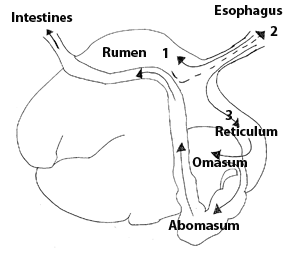
|
Inside a Deer
To fuel all of this activity, deer eat an amazing variety of things: buds, acorns, leaves, twigs, fruit, seeds, moss, lichens, fungi, aquatic plants, and grasses. They have even been seen munching on snails and dried fish! Deer need to eat ten pounds of food a day to survive, not an easy thing to do while you're looking for predators.
To allow deer to eat and run, they have a four-chambered stomach. The first chamber, called the rumen, stores food that has been quickly gobbled up. When the deer find a safe place to rest, they will regurgitate the food from the rumen up in a lump and rechew it. Then, they swallow the food again and it travels through their other three stomach chambers and into their intestines. A deer's stomach has millions of microorganisms in it which help digest the tough plant fibers a deer eats.
|
